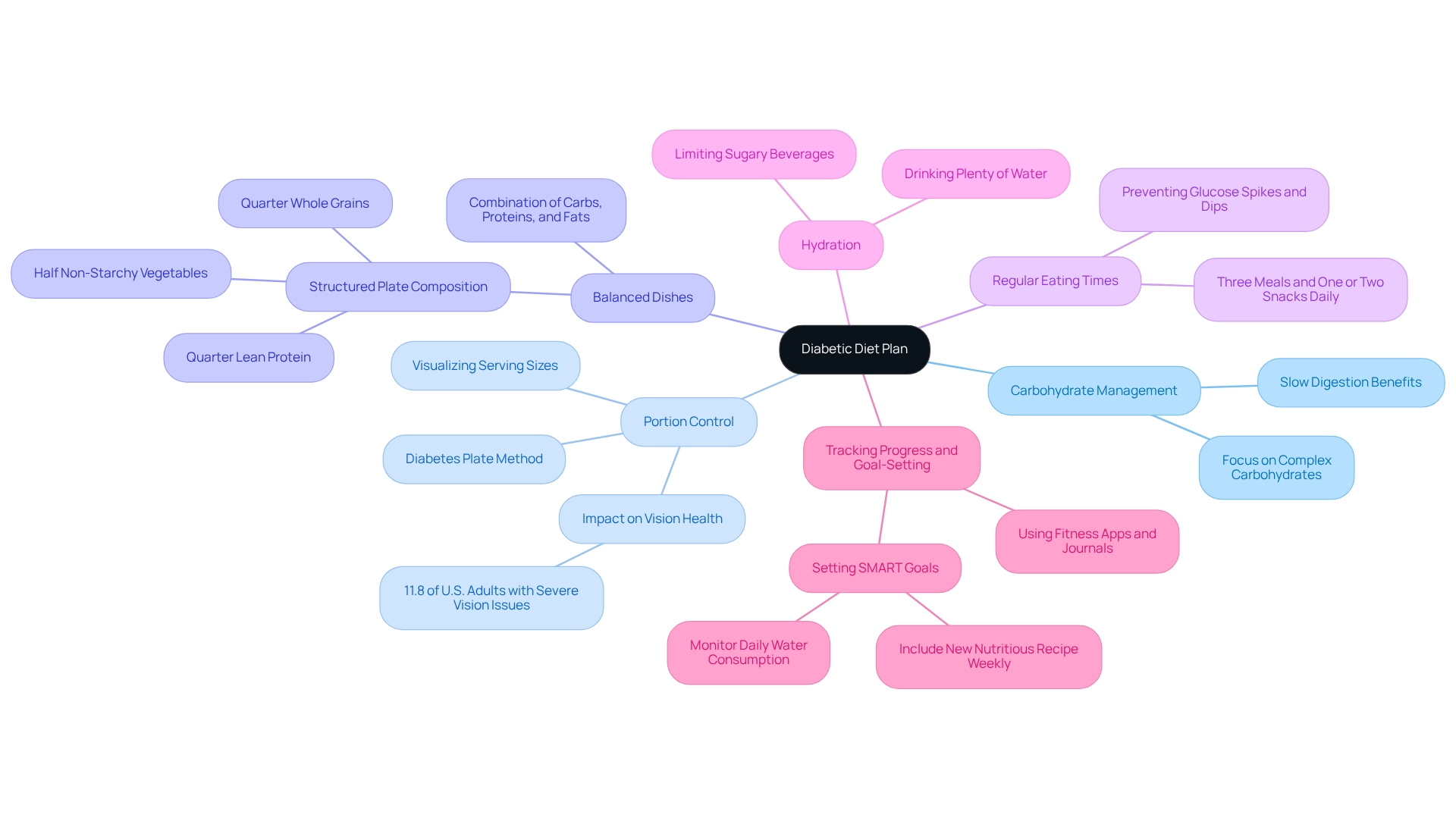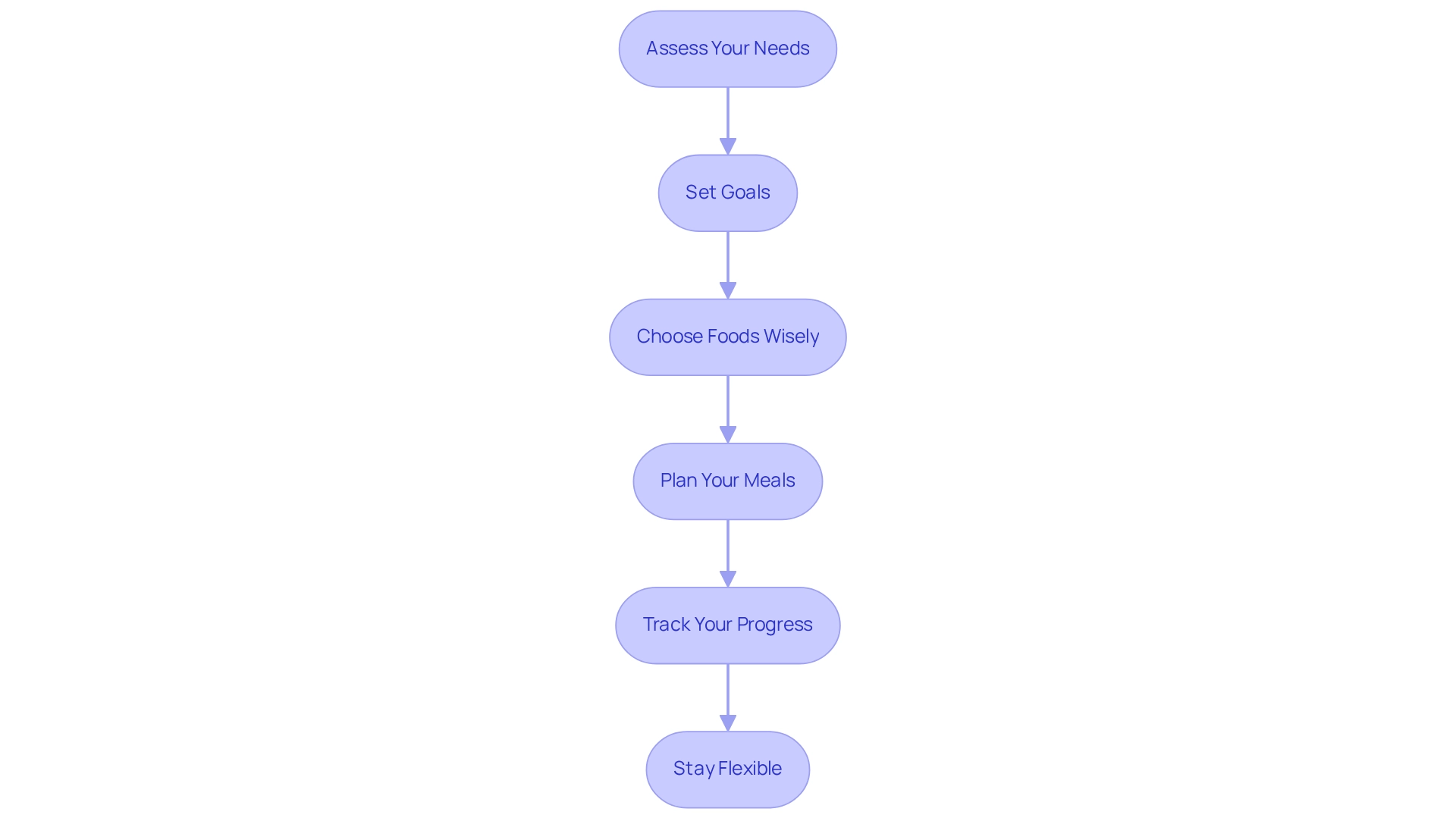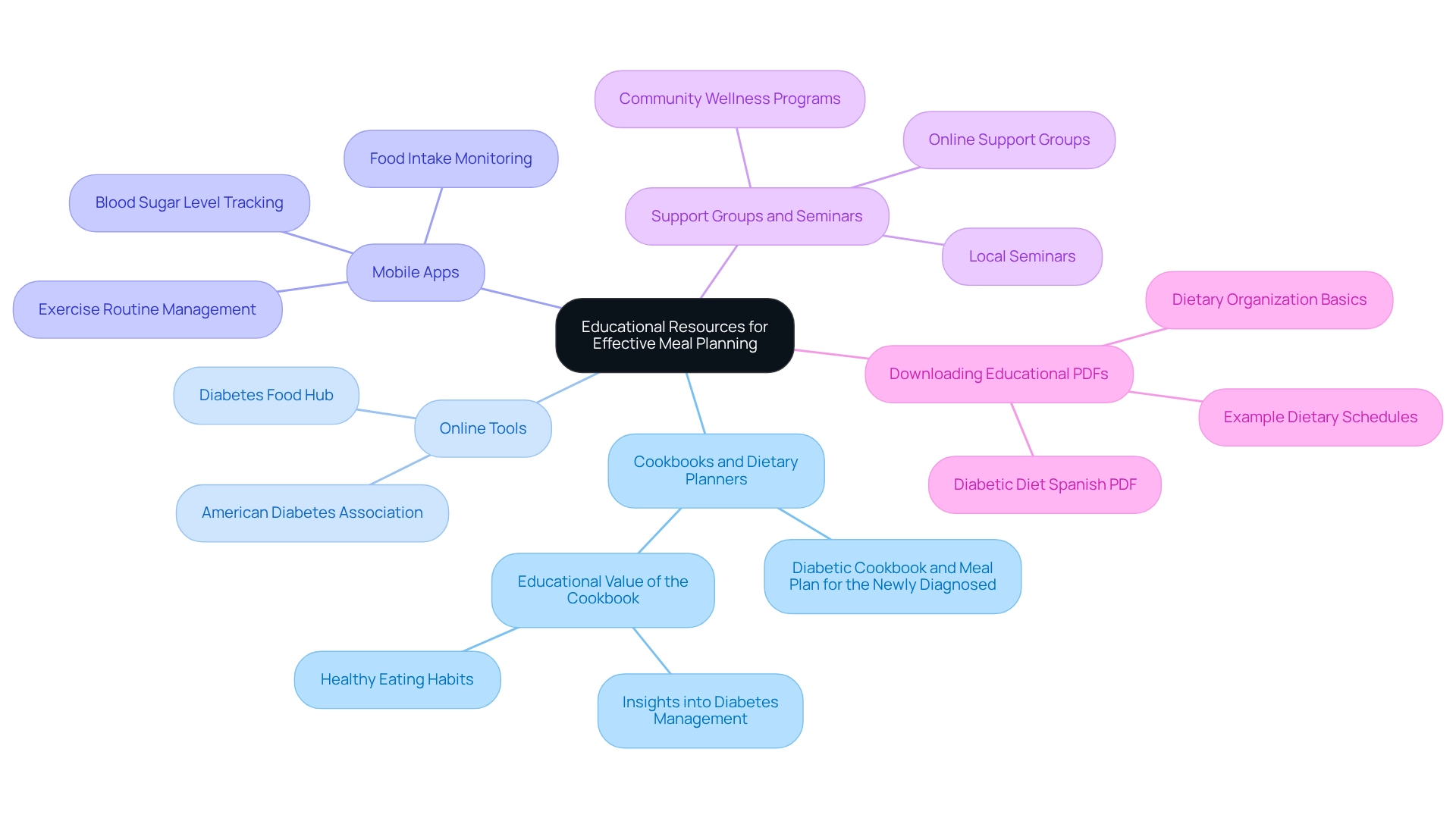Overview
This article highlights the creation of a diabetic diet Spanish PDF, aimed at facilitating effective meal planning for diabetes management.
It’s important to recognize that managing diabetes can be challenging, and this resource emphasizes essential components like:
- Carbohydrate management
- Portion control
- Balanced meals
Many patients find that establishing regular eating times is crucial for maintaining stable blood sugar levels.
By providing practical strategies and resources, this article seeks to help individuals tailor their diet, making it easier to navigate their journey toward better health.
Introduction
Navigating the complexities of a diabetic diet can feel overwhelming, can’t it? Yet, it is a crucial step toward effective diabetes management. By understanding foundational elements—like carbohydrate management, portion control, and balanced meals—you can set the stage for a healthier lifestyle. Many patients find that with tailored strategies for meal planning and progress tracking, they can create a diet that not only stabilizes blood sugar levels but also aligns with their personal preferences and health goals.
It’s important to recognize that by embracing educational resources and community support, anyone can take charge of their health journey, transforming dietary choices into powerful tools for well-being.
Understand the Basics of a Diabetic Diet Plan
Managing diabetes can feel overwhelming at times, but understanding your diet is a crucial step toward taking control of your health. A diabetic diet Spanish PDF is essential for managing blood sugar levels through informed food choices. Here are some key components to consider:
- Carbohydrate Management: It’s important to recognize the impact of carbohydrates on blood sugar. Focusing on complex carbohydrates, such as whole grains, legumes, and vegetables, is beneficial. These foods are digested more slowly, helping to stabilize your glucose levels and making a positive difference in your daily routine.
- Portion Control: Many patients find that implementing portion control techniques, like the Diabetes Plate method, can make a significant difference. This method aids in visualizing appropriate serving sizes, which is essential for maintaining balanced nutrition without excessive calorie consumption. It’s particularly crucial to keep in mind that 11.8% of U.S. adults with diabetes reported severe vision difficulties or blindness in 2019. By managing portion sizes, you can help mitigate these risks and promote better health outcomes.
- Balanced Dishes: Striving for dishes that include a combination of carbohydrates, proteins, and healthy fats can be rewarding. A well-structured plate might consist of half non-starchy vegetables, a quarter lean protein, and a quarter whole grains, ensuring nutritional balance that supports your overall well-being.
- Regular Eating Times: Consistency in meal timing is key to regulating blood sugar levels. Aiming for three meals and one or two snacks daily can help prevent spikes and dips in glucose levels, creating a more stable metabolic environment.
- Hydration: Staying adequately hydrated is vital for your overall health. Drinking plenty of water while limiting sugary beverages can help manage hunger and support metabolic functions.
In addition to these nutritional principles, integrating effective strategies for progress tracking and goal-setting can significantly enhance your diabetes management. Utilizing tools such as fitness apps, journals, and pedometers to monitor your dietary habits and physical activity empowers you to set SMART goals—specific, measurable, attainable, relevant, and time-bound. For instance, you could strive to include a new nutritious recipe in your diet each week or monitor your daily water consumption to ensure sufficient hydration.
By understanding these essential principles and actively participating in your health management, you can start to create a meal strategy that aligns with your health goals, using the guidelines from the diabetic diet Spanish PDF. As Dr. Jason Shumard emphasizes, “By providing patients with actionable insights and practical tools, the center fosters an environment where individuals can reclaim their health and well-being, ultimately leading to improved quality of life and reduced reliance on conventional medical interventions.” Furthermore, the center’s emphasis on patient education, as demonstrated in the case study named ‘Patient Education and Empowerment,’ highlights how knowledgeable patients can successfully manage their condition.
Develop Your Personalized Diabetic Diet Plan
Creating a personalized diabetic diet Spanish PDF can feel overwhelming, but it’s an important step toward better diabetes management. Let’s explore some key steps together that can truly enhance your journey:
- Assess Your Needs: It’s crucial to start by consulting with a healthcare provider or a registered dietitian. They can help you identify your unique nutritional needs based on your health status, activity level, and any medications you may be taking.
Set Goals: Establishing clear and achievable nutritional goals is vital. Using the SMART framework—specific, measurable, attainable, relevant, and time-bound—can guide you. Think about objectives like reaching a target weight, improving blood sugar control, or increasing your energy levels. For example, you might aim to reduce your blood sugar levels by a certain percentage within three months. Remember, setting realistic targets is key for long-term success. - Choose Foods Wisely: Selecting foods that meet your nutritional needs while also aligning with your personal preferences is essential. Aim to include a diverse range of fruits, vegetables, whole grains, lean proteins, and healthy fats in your diet. This variety not only nourishes your body but also keeps meals enjoyable.
- Plan Your Meals: Utilizing a meal planning template can help you organize your meals for the week. Ensure that each meal—breakfast, lunch, dinner, and snacks—is balanced and nutritious. This can greatly assist in stabilizing your blood sugar levels.
- Track Your Progress: Maintaining a food journal or using a mobile application can be incredibly beneficial for observing your nutritional intake and its impact on your blood sugar levels. Many patients find that implementing various tracking methods, like fitness apps and journals, allows for timely adjustments to their diet, fostering accountability and motivation.
- Stay Flexible: It’s important to incorporate flexibility into your diet strategy. Allowing for occasional treats or adjustments can help you maintain your eating routine over the long term, without feelings of deprivation.
Research shows that tailored nutrition strategies can lead to better outcomes for individuals with type 2 diabetes. A systematic review of 23 trials involving 1,357 participants highlighted the effectiveness of customized nutritional strategies in managing blood sugar levels. Additionally, case studies exploring machine learning in nutrition research suggest that personalized nutrition can enhance eating responses and weight loss results, although further refinement is needed.
As Bethenny Frankel wisely noted, making informed food choices is akin to making prudent financial investments; both require careful thought and preparation. The authors also extend their gratitude to Mark Begieneman for his invaluable assistance in drafting this manuscript, emphasizing the collaborative effort behind this research. Future trials should focus on dietary quality and allow for medication reduction while closely monitoring blood glucose levels, and using resources like a diabetic diet Spanish PDF can help develop a dietary approach that supports diabetes management and empowers you to take charge of your health. Remember, you are not alone on this journey, and with the right support, you can thrive.
Utilize Educational Resources for Effective Meal Planning
To enhance your meal planning efforts, consider the following educational resources that can truly make a difference in your journey:
-
Cookbooks and Dietary Planners: Have you explored diabetic-specific cookbooks? They offer customized recipes and dietary plans tailored to your needs. One particularly helpful resource is the ‘Diabetic Cookbook and Meal Plan for the Newly Diagnosed.’ It’s well-regarded for its informative material, helping individuals like you grasp effective management of the condition through practical cooking techniques. As Lori Zanini RD CDE wisely points out, “You’ll get a glimpse by looking over the screen shots wherein links to, for example, egg bites makes preparing such entrees easier than using a hardbound cookbook.”
-
Online Tools: Many patients find that utilizing platforms such as the American Diabetes Association and Diabetes Food Hub can be incredibly beneficial. These resources provide comprehensive planning tools, recipes, and expert advice to help you manage your blood sugar levels effectively. They are designed to simplify meal preparation and improve your food options.
-
Mobile Apps: Have you considered using management applications? These tools can assist you in monitoring your food intake, blood sugar levels, and exercise routines. Not only do they help you stay organized, but they also motivate you to stick to your dietary goals, making the process feel more manageable.
-
Support Groups and Seminars: Engaging with local seminars or online support groups can be a powerful way to share experiences and learn from others facing similar challenges. Dr. Shumard’s center frequently hosts events that provide valuable insights and foster community support, reinforcing a commitment to holistic health. Participating in community wellness programs can also offer tailored resources and support for effectively managing diabetes.
-
Downloading educational PDFs: Downloading educational PDFs, such as the diabetic diet spanish pdf, from reliable sources like the CDC or Northwestern Medicine can be a great step forward. These documents address dietary organization basics and provide example dietary schedules. They serve as excellent references for creating balanced and nutritious dishes, offering insights into effective planning strategies.
By leveraging these resources, including local community support and educational tools, you can acquire the knowledge and support necessary to develop effective meal plans that align with your health objectives. Remember, you are not alone in this journey; these tools can empower you to take control of your diabetes management and lead a healthier life.
Conclusion
Navigating a diabetic diet may initially feel overwhelming, but it’s important to recognize that understanding its core components can transform this challenge into an empowering journey toward better health. Key elements such as carbohydrate management, portion control, and balanced meals are fundamental in stabilizing blood sugar levels. By adhering to these principles and establishing regular meal times, many patients find that they can foster a more predictable metabolic environment that enhances overall well-being.
Creating a personalized diet plan is equally crucial, as it allows for tailored strategies that address individual health needs and preferences. Consulting with healthcare professionals, setting achievable goals, and tracking progress can lead to significant improvements in diabetes management. It’s essential to integrate flexibility within the meal plan, ensuring sustainability and enjoyment, which helps reduce feelings of deprivation.
Moreover, leveraging educational resources can greatly enhance meal planning efforts. From diabetic-specific cookbooks and online tools to mobile apps and community support, these resources provide valuable insights and practical strategies for effective diabetes management. Engaging with these tools not only aids in meal preparation but also fosters a sense of community and shared knowledge, reinforcing the importance of collective support in health journeys.
Ultimately, by embracing these strategies and resources, individuals can take control of their diabetes management. This proactive approach not only stabilizes blood sugar levels but also empowers individuals to make informed dietary choices that align with their health goals, leading to a healthier and more fulfilling life.
Frequently Asked Questions
Why is understanding diet important for managing diabetes?
Understanding your diet is crucial for managing diabetes as it helps control blood sugar levels through informed food choices.
What role do carbohydrates play in managing diabetes?
Carbohydrates significantly impact blood sugar levels. Focusing on complex carbohydrates, such as whole grains, legumes, and vegetables, can help stabilize glucose levels as they are digested more slowly.
How can portion control benefit individuals with diabetes?
Implementing portion control techniques, like the Diabetes Plate method, helps visualize appropriate serving sizes, which is essential for maintaining balanced nutrition and preventing excessive calorie consumption.
What does a balanced dish look like for someone with diabetes?
A balanced dish should include a combination of carbohydrates, proteins, and healthy fats, ideally consisting of half non-starchy vegetables, a quarter lean protein, and a quarter whole grains.
Why is it important to have regular eating times?
Consistency in meal timing helps regulate blood sugar levels. Aiming for three meals and one or two snacks daily can prevent spikes and dips in glucose levels.
How does hydration affect diabetes management?
Staying hydrated is vital for overall health. Drinking plenty of water while limiting sugary beverages can help manage hunger and support metabolic functions.
What strategies can enhance diabetes management?
Integrating strategies for progress tracking and goal-setting, such as using fitness apps, journals, and pedometers, can empower individuals to monitor dietary habits and physical activity.
What is the significance of patient education in managing diabetes?
Patient education empowers individuals to manage their condition effectively, leading to improved quality of life and reduced reliance on conventional medical interventions.


